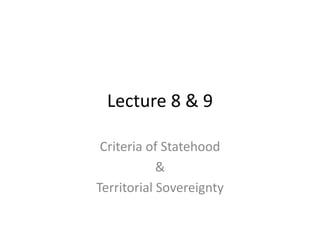
Lecture 8 & 9 criteria of statehood and territorial sovereignty
- 1. Lecture 8 & 9 Criteria of Statehood & Territorial Sovereignty
- 2. A) Recognition of State • When ones state recognised another entity as a ‘state’. • The importance of being recognised: only ‘state’ can acquire international legal personality (by the recognising state)
- 3. • The time of recognition is important because at that time, the recognised state will have international legal personality by the recognizing state.
- 4. • There are 3 theories in recognition: a)constitutive b)declaratory c)hybrid
- 5. • ‘formal acknowledgement or acceptance by a government of the independence and sovereignty of a newly created state or of a newly established government in another state, especially one establishing by revolution’.
- 6. a) Constitutive Theory • The act of recognition itself will make a political entity into a state and therefore became a subject of international law. Exception to this theory – Taiwan. • Although only 20 states recognised Taiwan (Malaysia excluding), nevertheless it has entered into international relations with almost every other states in the world.
- 7. b) Declaratory Theory • An entity will become a state and subsequently become a subject of international law as soon as it has all the four traditional qualifications for recognition. Exception to this – Palestine. • Recognised by more than 70 states (including Malaysia) and have observer status as United Nations (PLO) BUT it does not have a defined territory or habited by ‘permanent’ population and ‘effective’ government.
- 8. c) Hybrid Theory • Arise because both the constitutive and declaratory theory is not widely accepted by the majority states. • There must be a merger between these two theories.
- 10. • According to hybrid theory: a state can exist in fact as a subject of international law as soon as it satisfies the conditions of statehood, but it can only realise its full potential (as a state) only after it has been recognised.
- 11. B) Recognition of Government • If there’s a change of government in a state, then there’s a need to recognised the new government. • There is no need to recognise if the new government succeeded the old government by lawful means: Election.
- 12. • Problem arise when it is done through unlawful means. • For example revolution and non-constitutional means.
- 13. • In order for the new government to be recognised, it must: a) be effective b) have exclusive control over the territory of the state c) demonstrate its ability to honour international obligations d) be representative of all shades of opinion.